Module 2 Amazing things Unit 5 Period 1 Grammar 名词&代词another、other讲练课件(共38张PPT)
文档属性
| 名称 | Module 2 Amazing things Unit 5 Period 1 Grammar 名词&代词another、other讲练课件(共38张PPT) |
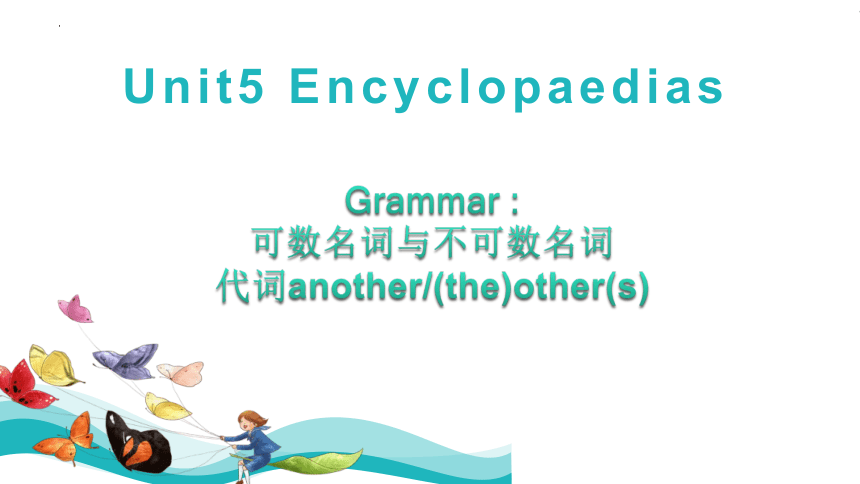
|
|
| 格式 | pptx | ||
| 文件大小 | 759.7KB | ||
| 资源类型 | 教案 | ||
| 版本资源 | 牛津上海版(试用本) | ||
| 科目 | 英语 | ||
| 更新时间 | 2023-09-23 15:06:29 | ||
图片预览


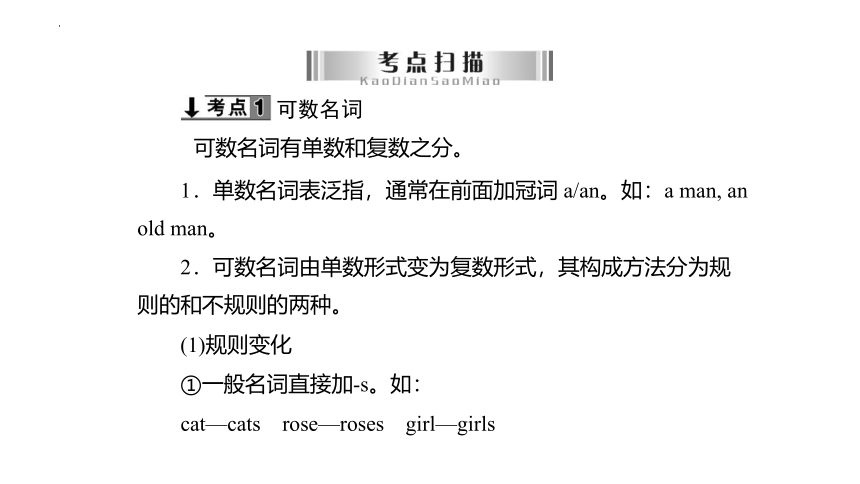
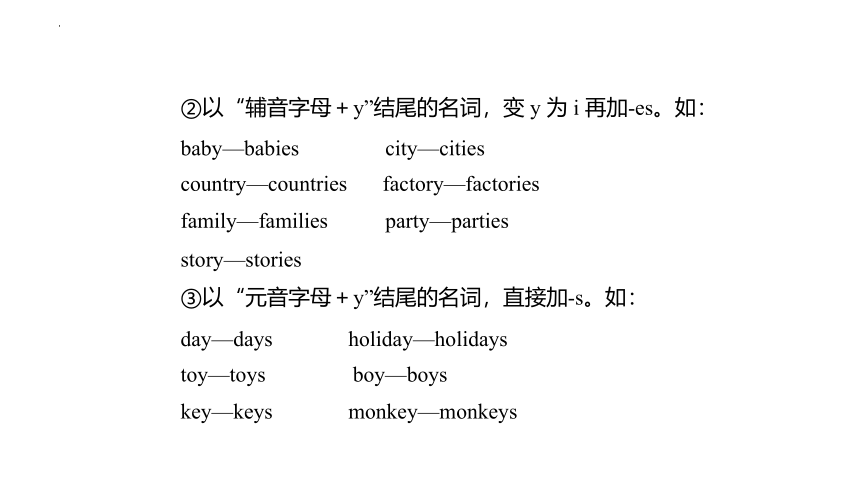
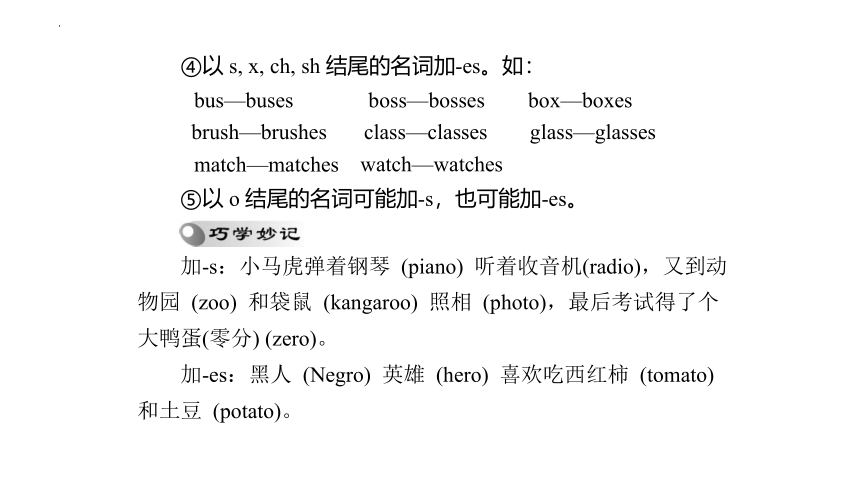
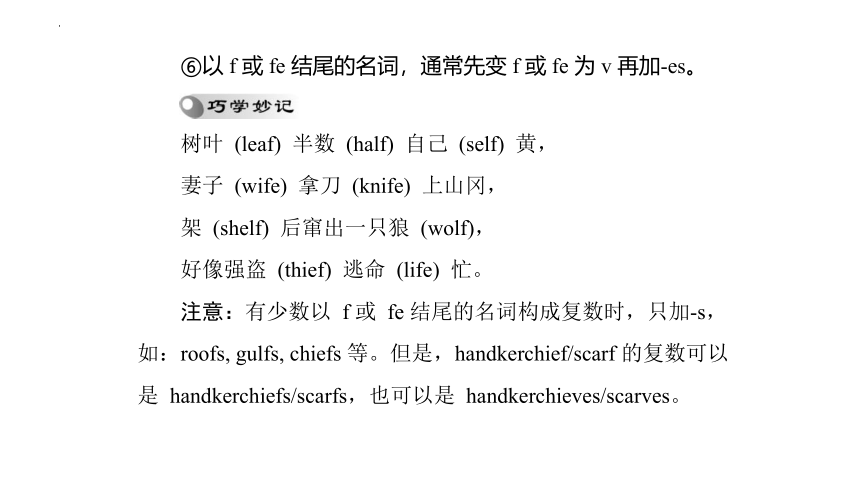

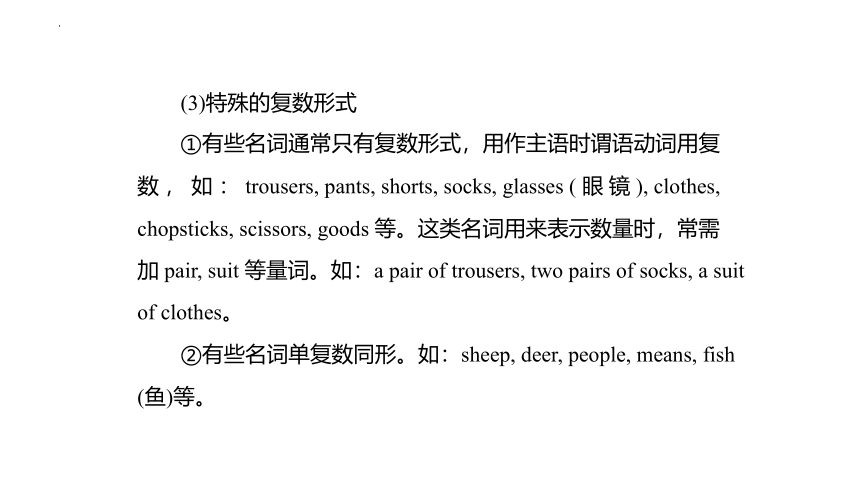
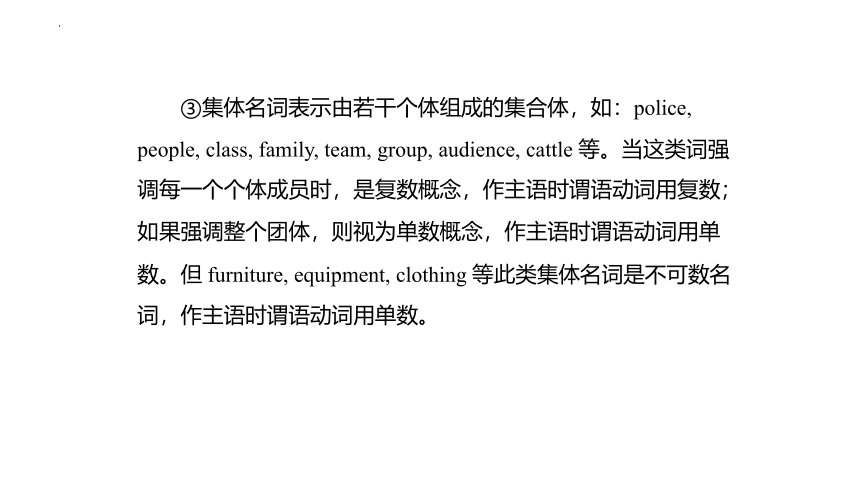
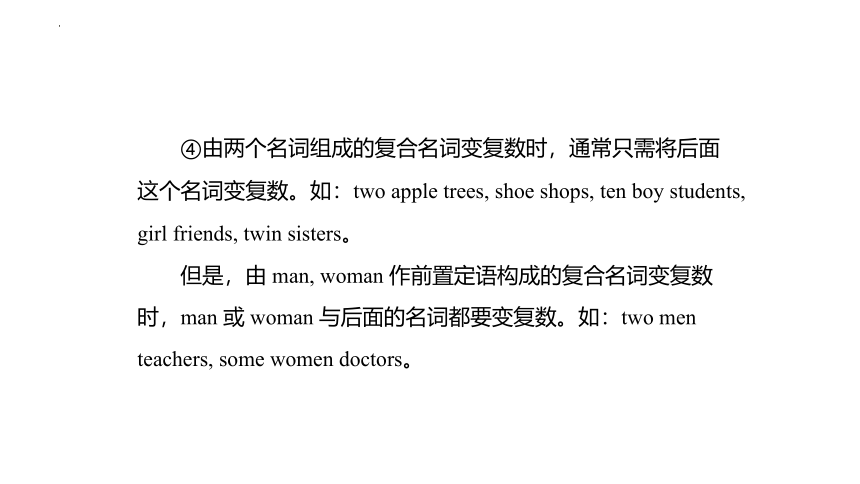


文档简介
(共38张PPT)
Unit5 Encyclopaedias
Grammar :
可数名词与不可数名词
代词another/(the)other(s)
第一部分 可数名词与不可数名词
可数名词
可数名词有单数和复数之分。
1.单数名词表泛指,通常在前面加冠词 a/an。如:a man, an
old man。
2.可数名词由单数形式变为复数形式,其构成方法分为规
则的和不规则的两种。
(1)规则变化
①一般名词直接加-s。如:
cat—cats
rose—roses
girl—girls
②以“辅音字母+y”结尾的名词,变 y 为 i 再加-es。如:
baby—babies
country—countries
family—families
city—cities
factory—factories
party—parties
story—stories
③以“元音字母+y”结尾的名词,直接加-s。如:
day—days
toy—toys
key—keys
holiday—holidays
boy—boys
monkey—monkeys
④以 s, x, ch, sh 结尾的名词加-es。如:
box—boxes
glass—glasses
bus—buses
brush—brushes
match—matches
boss—bosses
class—classes
watch—watches
⑤以 o 结尾的名词可能加-s,也可能加-es。
加-s:小马虎弹着钢琴 (piano) 听着收音机(radio),又到动
物园 (zoo) 和袋鼠 (kangaroo) 照相 (photo),最后考试得了个
大鸭蛋(零分) (zero)。
加-es:黑人 (Negro) 英雄 (hero) 喜欢吃西红柿 (tomato)
和土豆 (potato)。
⑥以 f 或 fe 结尾的名词,通常先变 f 或 fe 为 v 再加-es。
树叶 (leaf) 半数 (half) 自己 (self) 黄,
妻子 (wife) 拿刀 (knife) 上山冈,
架 (shelf) 后窜出一只狼 (wolf),
好像强盗 (thief) 逃命 (life) 忙。
注意:有少数以 f 或 fe 结尾的名词构成复数时,只加-s,
如:roofs, gulfs, chiefs 等。但是,handkerchief/scarf 的复数可以
是 handkerchiefs/scarfs,也可以是 handkerchieves/scarves。
(2)不规则变化(需记忆)
①改变字母变复数。如:
man—men
woman—women
policewoman—policewomen
fisherman—fishermen
foot—feet
tooth—teeth
goose—geese
mouse —mice
child—children
②表示“某国人”的名词单数变复数:
i.中国人 (Chinese)、日本人 (Japanese)、瑞士人 (Swiss)
单复数同形。
ii.英国/法国人改 a 为 e。如:
Englishman—Englishmen
Frenchman—Frenchmen
iii.其他以-an, -ian 结尾的各国人直接加-s。如:American(s),
German(s), Russian(s), Australian(s), Indian(s), Korean(s)。
(3)特殊的复数形式
①有些名词通常只有复数形式,用作主语时谓语动词用复
数 , 如 : trousers, pants, shorts, socks, glasses ( 眼 镜 ), clothes,
chopsticks, scissors, goods 等。这类名词用来表示数量时,常需
加 pair, suit 等量词。如:a pair of trousers, two pairs of socks, a suit
of clothes。
②有些名词单复数同形。如:sheep, deer, people, means, fish
(鱼)等。
③集体名词表示由若干个体组成的集合体,如:police,
people, class, family, team, group, audience, cattle 等。当这类词强
调每一个个体成员时,是复数概念,作主语时谓语动词用复数;
如果强调整个团体,则视为单数概念,作主语时谓语动词用单
数。但 furniture, equipment, clothing 等此类集体名词是不可数名
词,作主语时谓语动词用单数。
④由两个名词组成的复合名词变复数时,通常只需将后面
这个名词变复数。如:two apple trees, shoe shops, ten boy students,
girl friends, twin sisters。
但是,由 man, woman 作前置定语构成的复合名词变复数
时,man 或 woman 与后面的名词都要变复数。如:two men
teachers, some women doctors。
注意:
(1)有些名词的单复数形式的意义不同。如:
two fish 两条鱼
two fishes 两种鱼类
some people 一些人
some peoples 一些民族
(2)有些名词形式上是复数,但意义上是单数,一般看作单
数名词。如:news, mathematics/maths, physics, politics, the United
States, Niagara Falls 等。
不可数名词
1.不可数名词:一般指物质名词、抽象名词、专有名词等,
没有复数形式,其前不用冠词 a/an 或数词。
常见的不可数名词有:food, meat, fish, chicken, pork, beef,
mutton, drink, orange, milk, tea, coke, water, rice, bread,
homework, news, paper, ice, rain, snow, wind, air, weather, work
等。
分辨可数不可数的八句歌诀
可数不可数好分辨,名词所示物分两半;
如每半不能叫原名,那该词可数最公平;
每半还能把原名叫,不可数名词就遇到;
有的名词是两面堵,意变不可数为可数。
注意:有些名词有两个或两个以上不同的意思,其中一个
意思表示不可数名词,另外一个表示可数名词。如:
room 空间,余地,地方—a room 一间房间
paper 纸—a paper 一份试卷/一篇论文
glass 玻璃—a glass 一个玻璃杯—glasses 眼镜
orange 橙子汁—an orange 一个橙子
chicken 鸡肉—a chicken 一只小鸡
drink 饮料—a drink 一份饮料
fish 鱼(肉)—fishes 鱼的种类
time 时间—times 时代,次数
2.不可数名词量的表示
(1)不能与 a/an 或数字直接连用,但特指某物时可与 the 连
用。
(2)前面可加“数词/冠词+量词(可数)+of”。如:
a piece of paper/bread/news
一张纸/一片面包/一则新闻
two small bowls of rice 两小碗米饭
注意:
①加在不可数名词前的量词是可数的,所以当数词大于 1
时,量词要变为复数形式。如:
two cups of tea/coffee
three glasses of water
两杯茶/咖啡
三杯水
four pieces of advice 四条建议
②可数名词有时也可以用“数词/ 冠词+量词( 可数) +
of”结构来表示数量。请区别:
two boxes of chalk 两盒粉笔
two boxes of pears 两箱梨
3 .不可数名词前可用 much, little, a little, a lot of/lots of,
some, any 等表示量。如:
some/much money 一些/很多钱
a lot of information 许多信息
名词所有格
名词所有格用来表示名词和名词之间的所属关系。
1.有生命的名词的所有格
(1)一般名词(不以-s 结尾)的所有格是在词尾加“'s ”。如:
Lily's father 莉莉的爸爸
mother's birthday 母亲的生日
Children's Day 儿童节
men's clothes
男式服装
(2)以-s 或-es 结尾的名词,无论是单数还是复数,其所有
格只需在后面加“'”。如:
the doctors' office 医生办公室
the bus' door 公交车的门
(3)表示“两者(或以上)共同所有”时,只需在最后一个名
词后加“'s ”;若表示“两者(或以上)各自拥有”时,要在每一个
名词后都加“'s ”。如:
Lucy and Lily's room 露西和莉莉的房间(共同所有,只有
一个房间,room 用单数)
Lucy's and Lily's rooms 露西的房间和莉莉的房间(各自拥
有一个房间,room 用复数)
(4)在表示“某人的家”、“某种从业者的工作地点(如店
铺、诊所、餐馆等)”的名词所有格后面,一般省掉它所修饰的
名词。如:
at Mr.White's (house) 在怀特先生家
at the barber's (shop) 在理发店
at the doctor's (office) 在医生的诊所
(5)双重所有格:在表示所属物的名词前有冠词、数词、
不 定 代词 或 指 示 代词 ( 如 a, two, some, a few, this, that, these,
those 等)时,用“of+名词所有格”或“of+名词性物主代词”
来表示所属关系。如:
a photo of my father's
我父亲的一张照片
some inventions of Edison's
that novel of her brother's
爱迪生的一些发明
她兄弟的那本小说
a friend of mine=one of my friends
我的一位朋友
some students of John's=some of John's students
约翰的一些学生
2.无生命的名词的所有格
(1)一些无生命的名词的所有格要用“of”来表示。如:
a map of China 一张中国地图
the foot of the hill 山脚
the end of the term 学期末
the leaves of the tree 树叶
the title of the text 课文的标题
注意:如果名词后有一个较长的定语,尽管名词表示有生
命的东西,也可用 of 表示所属关系。如:
the story of Dr.Smith 史密斯博士的故事
the speech of President Obama 奥巴马总统的演讲
(2)表示时间、距离、长度、重量、价格等名词的所有格
要用“'s ”来表示。如:
one hundred miles' journey 一百英里的旅程
a boat's length 一条船的长度
two pounds' weight 两磅的重量
seven days' holiday=a seven-day holiday 七天的假期
six minutes' walk=a six-minute walk 步行六分钟的路程
ten dollars' worth 十美元的价值
注意:一些名词表示所属关系时,通常并不使用所有格,
而是借助于某些介词。如:
the key to the door 门的钥匙
the way to the school 去学校的路
the answer to the question 问题的答案
1.sound, voice, noise
(1)sound 指耳朵能听到的各种声音。
(2)voice 主要指人的嗓音和说话声音。
(3)noise 指噪音。
即景活用
voice
noise
sound
(1)Mary is a famous singer.She has a good ________.
(2)Don't make so much ________ in class.
(3)Can you hear the ________ of the water
2.work 与 job
(1)work 多指体力的或脑力的活动,为不可数名词。
(2)job 多指为换取报酬而进行的日常活动,为可数名词。
即景活用
job
work
He got a ________ by his hard________ at last.
3.problem 与 question
(1)problem 通常指客观上存在的等待解决的问题,尤其指
比较棘手的难题。
(2)question 通常指人主观上产生的疑问,以及用口头或书
面提出的问题。
即景活用
problems
questions
I have some ________ in learning English, so I should ask the
teacher a lot of ________ after class.
4.home, house, family
(1)home 指家,包括住处和家人。
(2)house 指房子、住宅。
(3)family 指家庭或家庭成员。
即景活用
house
family
home
(1)We bought a new ________ near the river.
(2)All my ________ are watching the Spring Festival Gala.
(3)I miss my parents so much and I want to go ________.
5.road, way, street
(1)road 意为“公路,马路”,指两侧之间可供行人或车
辆通过的宽阔而又平坦的大道。“在马路上”一般用 on the
road。
(2)way 意为“路线;路途;方法”,指从一地到另一地
的路途或解决问题的办法。常用固定短语有:in this way (用这
种方式), on the way to (在去……的路上), get in the way of (挡道)
等。
(3)street 意为“街道”,主要指两侧有房屋的道路。“在街
上”一般用 in the street。
即景活用
way
street
road
(1)Excuse me, could you tell me the ________ to the post
office
(2)When he went to work, he saw an old woman lying in the
________.
(3)The ________ in this village is wider than before.
第二部分 代词another/(the)other(s)
other, another, others, the other, the others
(1)other 多用作形容词,意为“别的,其余的”,指不确
定的别的人或物。
(2)another 指三者或三者以上之中的“另一个”人或物,
或在原来基础上增加一个,常修饰或代替单数名词。
注意:another+数词+复数名词=数词+more +复数名
词,表示“另外几个或再多几个……”。如:
another two days=two more days
再多两天,另外两天
(3)others=other+复数名词,无明确的范围,意为“其他
的人/物”。可以构成搭配“some...others...”,表示“一些……其
他的……”。
(4)the other 指两者之中的“另一个(特指剩下的那一个)”
人或物。可以构成搭配“one...the other...”,表示“一个……另一
个……”。the other 也可接复数可数名词,表示“其余(他)所有
的……”。
(5)the others=the other+复数名词,表示特定范围内除去
一部分后剩下的全部人或物,作主语时谓语动词用复数形式。
即景活用
another
the other
(1)The cake is delicious.Can I have ________ one
(2)He has two factories.One is in Dongguan, _________ is
in Huizhou.
(3)There are 50 students in our class.25 are boys, ________
are girls.
(4)There are many students on the playground.Some are
playing basketball, ________ are playing football.
(5)He is taller than any ________ boy in his class.
the others
others
other
Using
1.This _________ my ruler and those are my_________.
A.is; books B.is; book C.are; books D.are; book
2.Peter has lots of ________ to do, but he still enjoys reading ________ by Mark Twain.
A.work; work B.works; works
C.work; works D.works; work
3.I usually have ________ and ________ for breakfast.
A.breads; noodle B.breads; noodles C.bread; noodles D.bread; noodle
4.They come from different ________.
A.country B.countries C.a country D.countrys
5.Billy goes to the supermarket to buy two _________ for dinner every Saturday morning.
A.meat B.kilo of meat
C.kilos of meat D.kilos meat
6.— What would you like
— I would like ___________ first.
A.five cup of tea B.five cups of tea
C.five cup of teas D.five cups of teas
7.Are those your ________
A.tomatoes B.tomatos C.tomato D.tomatose
8.—What’s in the picture
—Three ________ and six________.
A.bus;women B.buses;woman
C.buses;women D.bus;woman
9.— Tony, how far is it from here to the library
— It’s twenty _________ bus ride.
A.minute B.minutes C.minute’s D.minutes’
10.—How many ________ can you see in the picture
—Only one.
A.dog B.sheep C.child D.news
Keys
1.A
【详解】句意:这是我的尺子,那些是我的书。
考查be动词及可数名词。根据题干可知,this“这个”,为单数,后用is;those“那些”,后接可数名词复数形式。故选A。
2.C
【详解】句意:彼得有许多工作要做,但他仍然喜欢阅读马克吐温的作品。
考查名词的用法。根据“has lots of...to do”可知是有很多工作要做,work“工作”是不可数名词,排除BD;根据“reading...by Mark Twain”可知是读马克吐温的作品,此处work“作品”是可数名词,用名词复数表示泛指。故选C。
3.C
【详解】句意:早饭我通常吃面包和面条。
考查名词的用法。bread面包,不可数名词,不能加s,排除AB;noodle面条,可数名词,常用复数。故选C。
4.B
【详解】句意:他们来自不同的国家。
考查可数名词及其单复数。different后面接可数名词的复数形式,country为可数名词,其复数形式为countries。故选B。
5.C
【详解】句意:每周六上午Billy去超市为晚餐买两公斤肉。
考查不可数名词的表达。meat是不可数名词,应用数词+量词+of,修饰不可数名词,a kilo of“一公斤”可以修饰meat,根据two可知,此空应填kilos of meat,故选C。
6.B
【详解】句意:——你想要什么?——我想先要五杯茶。
考查不可数名词及其数的表达。tea“茶”,不可数名词,要表达其数量应用量词表达,five“五”,后面的cup“茶杯”应用复数形式。故选B。
7.A
【详解】句意:那些是你的西红柿吗?
考查名词的复数形式。根据are可知,此空应填tomato的复数形式tomatoes,故选A。
8.C
【详解】句意:——照片里有什么?——三辆公交车和六个女人。
考查名词变复数。bus公交车,复数形式为buses;woman女人,复数形式为women。由空前数词three和six可知,都需要填入相应的复数形式。故选C。
9.D
【详解】句意:——托尼,从这里到图书馆有多远?——坐公共汽车要二十分钟。
考查名词所有格的用法。根据语境可知此处表示二十分钟的路程,应用名词所有格“’s形式”表示,空前有“twenty”修饰,因此名词“minute”需变为复数“minutes”,“minutes”的所有格形式是“minutes’”。故选D。
10.B
【详解】句意:——你在图片里能看见几只羊?——只有一只。
考查名词的数。dog狗,单数;sheep绵羊,单复数同形;child孩子,单数;news消息,不可数名词。How many后跟可数名词的复数。故选B。
Using
11.—Would you like some drinks, boys
—Yes, ________, please.
A.some oranges B.two glasses of oranges C.two pieces of bread D.two glasses of orange
12.There are many ________ on the farm and they are lovely.
A.sheep B.cow C.mouse D.horse
13.—I see ________ on the table. Are they for us, Dad
—Yes. One is for you and the other is for your brother.
A.two bowl of dumpling B.two bowls of dumpling
C.two bowl of dumplings D.two bowls of dumplings
14.When I finished my middle school, I started volunteering for a few nongovernmental (非政府的) ________.
A.organize B.organization C.organizations D.organizing
15.—Which of the two jackets would you like to buy
—Both. Then I can give one to my brother and leave ________ to myself.
A.another B.the other C.other D.others
16.Did they have ________ holiday in Paris
A.interesting B.interested C.an interesting D.an interest
17.Besides eating Zongzi, there are ________ ways to celebrate the Dragon Boat Festival.
A.other B.another C.the other D.others
18.Some people like to take a walk in their free time. ________ like to listen to music.
A.Other B.The others C.Others D.Another
19.There are two trees over there. A bird is singing ________ one tree and two boys are sitting under ________ tree.
A.in; other B.on; the other C.in; the other D.on; other
20.On ________ side of the road, there is a lovely garden full of flowers.
A.other B.the other C.another D.others
Keys
11.D
【详解】句意:——男孩们,你们想喝点什么吗?——好的,请给我们两杯橙汁。
考查不可数名词数量的表达。some oranges一些橘子;two glasses of oranges表达错误;two pieces of bread两片面包;two glasses of orange两杯橙汁。根据“Would you like some drinks”可知,询问要不要饮料,所以回答要两杯橙汁,“橙汁”orange,不可数名词。故选D。
12.A
【详解】句意:农场里有许多羊,它们很可爱。
考查名词单复数的用法。sheep羊,单复同形;cow奶牛,名词单数;mouse老鼠,名词单数;horse马,名词单数。many修饰可数名词复数,只有选项A符合,故选A。
13.D
【详解】句意:——我在桌子上看见两碗饺子。爸爸,它们是给我们的吗?——是的。一碗给你,另一碗给你弟弟。
考查数词用法。bowl可数名词,two后接复数,two bowls of后接dumpling复数。故选D。
14.C
【详解】句意:中学毕业后,我开始在一些非政府组织做志愿者。
考查可数名词复数。organize组织,动词;organization组织,可数名词单数;organizations组织,可数名词复数;organizing组织,动名词或现在分词。a few后接可数名词复数。故选C。
15.B
【详解】句意:——这两件夹克,你想要选择哪一件?——两件都要。然后我给我哥哥一件,留另一件给自己。
考查代词。another三者或三者以上中的另一个;the other两者中的另一个;other其他的,修饰复数名词;others其他的人或事物。根据“the two jackets”可知此处指的是两件夹克中的另一件,故用the other。故选B。
16.C
【详解】句意:他们在巴黎度过了一个有趣的假期吗?
考查形容词辨析和名词的用法。interesting有趣的;interested感兴趣的;interest兴趣。此处作定语修饰holiday,用interesting,修饰可数名词单数holiday,形容词前需加冠词an。故选C。
17.A
【详解】句意:除了吃粽子,还有其他庆祝端午节的方式。
考查代词辨析。other其他的,后跟名词;another(三者或三者以上)另一个;the other(两者中的)另一个;others其他的(相当于other+名词复数)。根据“Besides eating Zongzi...ways”可知此处是表达其他的方式,ways是复数名词,空处用other。故选A。
18.C
【详解】句意:一些人喜欢在空闲时间散步,另一些人喜欢听音乐。
考查代词辨析。Other其他的;The others特指剩余的所有人或物;Others泛指剩余的一部分;Another另一个。此处和“Some people”对应的应该是others,some ... others“一些……另一些……”。故选C。
19.C
【详解】句意:那儿有两棵树。一只鸟在其中一棵树上唱歌,两个男孩儿坐在另一棵树下。
考查介词和代词辨析。in在……里;on在……上;other其他的,表泛指;the other特指两者中的另一个。根据“A bird is singing ... one tree”可知,此处表示鸟在树上,鸟不属于树本身长的东西,因此用介词in;由“There are two trees over there.”可知,空二表示两个男孩坐在另一棵树下,表示特指两棵中的另一棵,用the other。故选C。
20.B
【详解】句意:马路的另一边有一个充满鲜花的漂亮花园。
考查形容词。other 其他的,另外的,泛指另一个、另一些,作定语时,常与可数名词复数连用;the other 可作代词也可作形容词,表(两者中的)另一个,常用于one...the other...的句型中;another 泛指(指三者或三者以上中的)另一个,既可作代词又可作形容词;others 泛指别的、其他人,是other的复数形式,相当于other+可数名词复数。此处指道路的另一边,道路只有两边,所以另一边用the other side。故选B。
Using
21.This apple is delicious. Could I have ________ one
A.another B.any C.other D.others
22.—Can you take me to the zoo today, Dad
— Sorry, my dear. I’m very busy. Let’s go there ________ day.
A.any B.another C.other D.others
23.—The shoes are so large. Could you please show me _________ pair
—Sure. You can try this pair.
A.the other B.other C.another D.others
24.The shirt is a little expensive. Could you please show me ________ one
A.the others B.more C.others D.another
25.I don’t like fall behind __________ students.
A.the other B.the others C.others D.another
26.Please give me ________. I am so hungry.
A.two bread B.two breads
C.two pieces of breads D.two pieces of bread
27.There are________ in the pond.
A.many fish B.much fishes C.much fish D.a fish
28.I often go to school on foot. It’s about ______ from my house to our school.
A.20 minutes’ walk B.20 minute’s walk
C.walk of 20 minutes D.20 minute’s walks
29.It’s a music festival. Look, some ______ are dancing over there.
A.nine years old girls B.nine-year-old girl
C.nine-year-old girls D.nine years old girl
30.Please give me two ________.
A.pieces of paper B.piece of papers C.pieces paper D.piece papers
Keys
21.A
【详解】句意:这个苹果是美味的。我能再要一个吗?
考查代词辨析。another另一个;any任何;other其他的;others其他人。根据“This apple is delicious. ”可知,苹果是美味的,所以我想再要另外一个。故选A。
22.B
【详解】句意:——爸爸,你今天可以带我去动物园吗?——对不起,亲爱的。我很忙。我们改天去吧。
考查代词辨析。any任何;another任何一个;other其他的,后接复数名词;others其它的人或物,后不接名词。根据“I’m very busy. Let’s go there …day”可知,今天很忙,所以改天去,不确定中的另一个应填another,故选B。
23.C
【详解】句意:——这双鞋太大了。你能给我看另一双吗?——可以。你可以试下这双。
考查代词辨析。the other两者中另一个;other其他的,后接名词复数;another泛指三者及以上中另一个;others其他的人或物。此处指看下很多鞋子中的另一双,表泛指,应用another。故选C。
24.D
【详解】句意:这件衬衫有点贵。你能给我看另一件吗?
考查不定代词。the others特指某一范围内的“其他的(人或物)”,是the other的复数形式;more“更、更多”;others其他人或物,复数概念;another指三者或三者以上的另一个,用作形容词或代词。根据“one”,可知此处泛指另一个、另一件,故选D。
25.A
【详解】句意:我不喜欢落后于其他学生。
考查代词和形容词词义辨析。the other特指两者中的另一个,常与one连用,构成one...the other的结构,意为“一个……另一个……”;other其他的,另外的,常与可数名词复数连用,但如果前面有the、some、any、each、every及形容词性物主代词时,可与可数名词单数连用,即the other+可数名词单数;the others特指某一范围内“全部或其余的人或物”,相当于the other +可数名词复数;others另一些,相当于other+可数名词复数,表示除去一部分后的另一些,但不是剩下的全体;another三个及以上的另一个,修饰可数名词单数。根据students可知特指其他的学生,空格处应用形容词作定语,the other符合题意,故选A。
26.D
【详解】句意:请给我两片面包。我如此饿。
考查不可数名词的表达。bread是不可数名词,故表示“两片面包”用two pieces of bread。故选D。
27.A
【详解】句意:池塘里有许多鱼。
考查可数名词复数的不规则变化。fish既可作可数名词也可作不可数名词,fish鱼肉,不可数名词;fish鱼,可数名词单数和复数形式相同。根据“There are...in the pond.”可知,此处表达池塘里有很多鱼,此处fish作可数名词复数形式,用many修饰。故选A。
28.A
【详解】句意:我经常步行去学校。从我家到我们学校大约步行20分钟。
考查距离的表达。根据“from my house to our school”可知,介绍从家到学校的距离,用基数词+复数形式的名词所有格+名词,故选A。
29.C
【详解】句意:它是一个音乐节日。看,一些九岁的女孩子正在那边跳舞。
考查定语。nine years old 九岁,作表语;nine-year-old 九岁的,作定语。girl名词前应该用定语nine-year-old,some后接可数名词复数。故选C。
30.A
【详解】句意:请给我两张纸。
考查不可数名词数量的表达。paper表示“纸张”,为不可数名词,无复数形式,可排除B和D选项,表示数量时候应用“基数词+量词+of+不可数名词”的结构,two后接可数名词复数。故选A。
Using
31.—What are those over there
—Oh, they are ________.
A.knife B.a knife C.knifes D.knives
32.All ________ received fresh flowers on Women’s Day.
A.woman teacher B.man teachers
C.women teachers D.men teacher
33.________ and sweet ________ are good for our eyes.
A.Carrot;potato B.Carrots;potatos
C.Carrots;potatoes D.Carrot;potatos
34.There are ______ in the river.
A.many fishes B.much fish C.much fishes D.more fish
35.Are there many _________ on the farm
A.horse B.cow C.dog D.sheep
36.Look! On the table is some ________ and in the box are some ________.
A.chicken;pears B.chickens;pears
C.chicken;pear D.chickens;pear
37.—Hello, what can I do for you
—I need some ________ and ________.
A.apple; bread B.apples; bread
C.apple; breads D.apples; breads
38.—What do you like for breakfast
—________
A.Two piece of bread.
B.Two pieces of bread.
C.Two pieces of breads.
D.Two piece of breads.
39.—It’s too hot! Let’s have some ________ to drink.
—Good idea.
A.eggs B.milks C.bread D.water
40.—What do we need for the salad
—We need two apples and three ________.
A.egg B.tomatoes C.pear D.banana
Keys
31.D
【详解】句意:——那边的那些是什么?——哦,它们是刀子。
考查名词单复数。knife刀子,单数;a knife一把刀子;knifes语法错误;knives复数。根据题干中的they可知,指代复数,应用knife的复数形式knives。故选D。
32.C
【详解】句意:在妇女节那天所有的女老师收到鲜花。
考查复合名词的复数。根据All可知,此空应填复数形式,women或man与其他名词构成的复合词,变复数时两个单词都要变复数,所以此空应填women teachers,故选C。
33.C
【详解】句意:胡萝卜和红薯对我们的眼睛很有好处。
考查名词用法。carrot胡萝卜,单数形式;carrots胡萝卜,复数形式;sweet potato红薯,单数形式;sweet potatoes红薯,复数形式。由于可数名词单数必须有限定词,不能单独使用,所以两空都用名词复数形式,carrot的复数为carrots,potato的复数为potatoes。故选C。
34.A
【详解】句意:在河里有很多鱼。
考查名词的数和主谓一致。fish鱼,可数名词;鱼肉,不可数名词。many修饰可数名词复数,much修饰不可数名词。结合“are”及 “in the river”可知,在河里的应是鱼,空处应是可数名词复数,故选A。
35.D
【详解】句意:农场上有很多绵羊吗?
考查名词。horse马,单数;cow奶牛,单数;dog狗,单数;sheep绵羊,单复数同形。many修饰复数名词,名词sheep的单复数同形,因此在句中应是作复数用。故选D。
36.A
【详解】句意:看!桌子上有一些鸡肉,盒子里有一些梨。
考查名词。第一个空,chicken鸡肉,不可数名词;chickens小鸡,名词复数。pear梨子,名词单数形式;pears梨子,名词复数形式。根据句中“is”可知,第一空填不可数名词chicken。第二个空,some意为“一些”,修饰可数名词pear的复数pears。故选A。
37.B
【详解】句意:——你好,我能为你做什么?——我需要一些苹果和面包。
考查名词的数。some“一些”,后面跟可数名词的复数形式或不可数名词。apple“苹果”,是可数名词,故第一个空填apple的复数形式apples;bread“面包”,不可数名词,故第二个空填bread。故选B。
38.B
【详解】句意:——你早餐喜欢吃什么?——两片面包。
考查不可数名词及其数的表达。bread“面包”,不可数名词,要表达其数量时应用量词,Two“二”,后面的piece“片,块”应用复数形式。故选B。
39.D
【详解】句意:——太热了!我们喝点水吧。——好主意。
考查名词。eggs鸡蛋;milk牛奶,不可数名词;bread面包,不可数名词;water水,不可数名词。根据“It’s too hot!”及横线后的“to drink”。只能是water或者milk,milk为不可数,不加s,可知只有water符合语境。故选D。
40.B
【详解】句意:——我们做沙拉需要什么?——我们需要两个苹果和三个西红柿。
考查名词的数。egg鸡蛋,单数;tomatoes西红柿,复数;pear梨,单数;banana香蕉,单数。three后面接复数名词,故选B。
Unit5 Encyclopaedias
Grammar :
可数名词与不可数名词
代词another/(the)other(s)
第一部分 可数名词与不可数名词
可数名词
可数名词有单数和复数之分。
1.单数名词表泛指,通常在前面加冠词 a/an。如:a man, an
old man。
2.可数名词由单数形式变为复数形式,其构成方法分为规
则的和不规则的两种。
(1)规则变化
①一般名词直接加-s。如:
cat—cats
rose—roses
girl—girls
②以“辅音字母+y”结尾的名词,变 y 为 i 再加-es。如:
baby—babies
country—countries
family—families
city—cities
factory—factories
party—parties
story—stories
③以“元音字母+y”结尾的名词,直接加-s。如:
day—days
toy—toys
key—keys
holiday—holidays
boy—boys
monkey—monkeys
④以 s, x, ch, sh 结尾的名词加-es。如:
box—boxes
glass—glasses
bus—buses
brush—brushes
match—matches
boss—bosses
class—classes
watch—watches
⑤以 o 结尾的名词可能加-s,也可能加-es。
加-s:小马虎弹着钢琴 (piano) 听着收音机(radio),又到动
物园 (zoo) 和袋鼠 (kangaroo) 照相 (photo),最后考试得了个
大鸭蛋(零分) (zero)。
加-es:黑人 (Negro) 英雄 (hero) 喜欢吃西红柿 (tomato)
和土豆 (potato)。
⑥以 f 或 fe 结尾的名词,通常先变 f 或 fe 为 v 再加-es。
树叶 (leaf) 半数 (half) 自己 (self) 黄,
妻子 (wife) 拿刀 (knife) 上山冈,
架 (shelf) 后窜出一只狼 (wolf),
好像强盗 (thief) 逃命 (life) 忙。
注意:有少数以 f 或 fe 结尾的名词构成复数时,只加-s,
如:roofs, gulfs, chiefs 等。但是,handkerchief/scarf 的复数可以
是 handkerchiefs/scarfs,也可以是 handkerchieves/scarves。
(2)不规则变化(需记忆)
①改变字母变复数。如:
man—men
woman—women
policewoman—policewomen
fisherman—fishermen
foot—feet
tooth—teeth
goose—geese
mouse —mice
child—children
②表示“某国人”的名词单数变复数:
i.中国人 (Chinese)、日本人 (Japanese)、瑞士人 (Swiss)
单复数同形。
ii.英国/法国人改 a 为 e。如:
Englishman—Englishmen
Frenchman—Frenchmen
iii.其他以-an, -ian 结尾的各国人直接加-s。如:American(s),
German(s), Russian(s), Australian(s), Indian(s), Korean(s)。
(3)特殊的复数形式
①有些名词通常只有复数形式,用作主语时谓语动词用复
数 , 如 : trousers, pants, shorts, socks, glasses ( 眼 镜 ), clothes,
chopsticks, scissors, goods 等。这类名词用来表示数量时,常需
加 pair, suit 等量词。如:a pair of trousers, two pairs of socks, a suit
of clothes。
②有些名词单复数同形。如:sheep, deer, people, means, fish
(鱼)等。
③集体名词表示由若干个体组成的集合体,如:police,
people, class, family, team, group, audience, cattle 等。当这类词强
调每一个个体成员时,是复数概念,作主语时谓语动词用复数;
如果强调整个团体,则视为单数概念,作主语时谓语动词用单
数。但 furniture, equipment, clothing 等此类集体名词是不可数名
词,作主语时谓语动词用单数。
④由两个名词组成的复合名词变复数时,通常只需将后面
这个名词变复数。如:two apple trees, shoe shops, ten boy students,
girl friends, twin sisters。
但是,由 man, woman 作前置定语构成的复合名词变复数
时,man 或 woman 与后面的名词都要变复数。如:two men
teachers, some women doctors。
注意:
(1)有些名词的单复数形式的意义不同。如:
two fish 两条鱼
two fishes 两种鱼类
some people 一些人
some peoples 一些民族
(2)有些名词形式上是复数,但意义上是单数,一般看作单
数名词。如:news, mathematics/maths, physics, politics, the United
States, Niagara Falls 等。
不可数名词
1.不可数名词:一般指物质名词、抽象名词、专有名词等,
没有复数形式,其前不用冠词 a/an 或数词。
常见的不可数名词有:food, meat, fish, chicken, pork, beef,
mutton, drink, orange, milk, tea, coke, water, rice, bread,
homework, news, paper, ice, rain, snow, wind, air, weather, work
等。
分辨可数不可数的八句歌诀
可数不可数好分辨,名词所示物分两半;
如每半不能叫原名,那该词可数最公平;
每半还能把原名叫,不可数名词就遇到;
有的名词是两面堵,意变不可数为可数。
注意:有些名词有两个或两个以上不同的意思,其中一个
意思表示不可数名词,另外一个表示可数名词。如:
room 空间,余地,地方—a room 一间房间
paper 纸—a paper 一份试卷/一篇论文
glass 玻璃—a glass 一个玻璃杯—glasses 眼镜
orange 橙子汁—an orange 一个橙子
chicken 鸡肉—a chicken 一只小鸡
drink 饮料—a drink 一份饮料
fish 鱼(肉)—fishes 鱼的种类
time 时间—times 时代,次数
2.不可数名词量的表示
(1)不能与 a/an 或数字直接连用,但特指某物时可与 the 连
用。
(2)前面可加“数词/冠词+量词(可数)+of”。如:
a piece of paper/bread/news
一张纸/一片面包/一则新闻
two small bowls of rice 两小碗米饭
注意:
①加在不可数名词前的量词是可数的,所以当数词大于 1
时,量词要变为复数形式。如:
two cups of tea/coffee
three glasses of water
两杯茶/咖啡
三杯水
four pieces of advice 四条建议
②可数名词有时也可以用“数词/ 冠词+量词( 可数) +
of”结构来表示数量。请区别:
two boxes of chalk 两盒粉笔
two boxes of pears 两箱梨
3 .不可数名词前可用 much, little, a little, a lot of/lots of,
some, any 等表示量。如:
some/much money 一些/很多钱
a lot of information 许多信息
名词所有格
名词所有格用来表示名词和名词之间的所属关系。
1.有生命的名词的所有格
(1)一般名词(不以-s 结尾)的所有格是在词尾加“'s ”。如:
Lily's father 莉莉的爸爸
mother's birthday 母亲的生日
Children's Day 儿童节
men's clothes
男式服装
(2)以-s 或-es 结尾的名词,无论是单数还是复数,其所有
格只需在后面加“'”。如:
the doctors' office 医生办公室
the bus' door 公交车的门
(3)表示“两者(或以上)共同所有”时,只需在最后一个名
词后加“'s ”;若表示“两者(或以上)各自拥有”时,要在每一个
名词后都加“'s ”。如:
Lucy and Lily's room 露西和莉莉的房间(共同所有,只有
一个房间,room 用单数)
Lucy's and Lily's rooms 露西的房间和莉莉的房间(各自拥
有一个房间,room 用复数)
(4)在表示“某人的家”、“某种从业者的工作地点(如店
铺、诊所、餐馆等)”的名词所有格后面,一般省掉它所修饰的
名词。如:
at Mr.White's (house) 在怀特先生家
at the barber's (shop) 在理发店
at the doctor's (office) 在医生的诊所
(5)双重所有格:在表示所属物的名词前有冠词、数词、
不 定 代词 或 指 示 代词 ( 如 a, two, some, a few, this, that, these,
those 等)时,用“of+名词所有格”或“of+名词性物主代词”
来表示所属关系。如:
a photo of my father's
我父亲的一张照片
some inventions of Edison's
that novel of her brother's
爱迪生的一些发明
她兄弟的那本小说
a friend of mine=one of my friends
我的一位朋友
some students of John's=some of John's students
约翰的一些学生
2.无生命的名词的所有格
(1)一些无生命的名词的所有格要用“of”来表示。如:
a map of China 一张中国地图
the foot of the hill 山脚
the end of the term 学期末
the leaves of the tree 树叶
the title of the text 课文的标题
注意:如果名词后有一个较长的定语,尽管名词表示有生
命的东西,也可用 of 表示所属关系。如:
the story of Dr.Smith 史密斯博士的故事
the speech of President Obama 奥巴马总统的演讲
(2)表示时间、距离、长度、重量、价格等名词的所有格
要用“'s ”来表示。如:
one hundred miles' journey 一百英里的旅程
a boat's length 一条船的长度
two pounds' weight 两磅的重量
seven days' holiday=a seven-day holiday 七天的假期
six minutes' walk=a six-minute walk 步行六分钟的路程
ten dollars' worth 十美元的价值
注意:一些名词表示所属关系时,通常并不使用所有格,
而是借助于某些介词。如:
the key to the door 门的钥匙
the way to the school 去学校的路
the answer to the question 问题的答案
1.sound, voice, noise
(1)sound 指耳朵能听到的各种声音。
(2)voice 主要指人的嗓音和说话声音。
(3)noise 指噪音。
即景活用
voice
noise
sound
(1)Mary is a famous singer.She has a good ________.
(2)Don't make so much ________ in class.
(3)Can you hear the ________ of the water
2.work 与 job
(1)work 多指体力的或脑力的活动,为不可数名词。
(2)job 多指为换取报酬而进行的日常活动,为可数名词。
即景活用
job
work
He got a ________ by his hard________ at last.
3.problem 与 question
(1)problem 通常指客观上存在的等待解决的问题,尤其指
比较棘手的难题。
(2)question 通常指人主观上产生的疑问,以及用口头或书
面提出的问题。
即景活用
problems
questions
I have some ________ in learning English, so I should ask the
teacher a lot of ________ after class.
4.home, house, family
(1)home 指家,包括住处和家人。
(2)house 指房子、住宅。
(3)family 指家庭或家庭成员。
即景活用
house
family
home
(1)We bought a new ________ near the river.
(2)All my ________ are watching the Spring Festival Gala.
(3)I miss my parents so much and I want to go ________.
5.road, way, street
(1)road 意为“公路,马路”,指两侧之间可供行人或车
辆通过的宽阔而又平坦的大道。“在马路上”一般用 on the
road。
(2)way 意为“路线;路途;方法”,指从一地到另一地
的路途或解决问题的办法。常用固定短语有:in this way (用这
种方式), on the way to (在去……的路上), get in the way of (挡道)
等。
(3)street 意为“街道”,主要指两侧有房屋的道路。“在街
上”一般用 in the street。
即景活用
way
street
road
(1)Excuse me, could you tell me the ________ to the post
office
(2)When he went to work, he saw an old woman lying in the
________.
(3)The ________ in this village is wider than before.
第二部分 代词another/(the)other(s)
other, another, others, the other, the others
(1)other 多用作形容词,意为“别的,其余的”,指不确
定的别的人或物。
(2)another 指三者或三者以上之中的“另一个”人或物,
或在原来基础上增加一个,常修饰或代替单数名词。
注意:another+数词+复数名词=数词+more +复数名
词,表示“另外几个或再多几个……”。如:
another two days=two more days
再多两天,另外两天
(3)others=other+复数名词,无明确的范围,意为“其他
的人/物”。可以构成搭配“some...others...”,表示“一些……其
他的……”。
(4)the other 指两者之中的“另一个(特指剩下的那一个)”
人或物。可以构成搭配“one...the other...”,表示“一个……另一
个……”。the other 也可接复数可数名词,表示“其余(他)所有
的……”。
(5)the others=the other+复数名词,表示特定范围内除去
一部分后剩下的全部人或物,作主语时谓语动词用复数形式。
即景活用
another
the other
(1)The cake is delicious.Can I have ________ one
(2)He has two factories.One is in Dongguan, _________ is
in Huizhou.
(3)There are 50 students in our class.25 are boys, ________
are girls.
(4)There are many students on the playground.Some are
playing basketball, ________ are playing football.
(5)He is taller than any ________ boy in his class.
the others
others
other
Using
1.This _________ my ruler and those are my_________.
A.is; books B.is; book C.are; books D.are; book
2.Peter has lots of ________ to do, but he still enjoys reading ________ by Mark Twain.
A.work; work B.works; works
C.work; works D.works; work
3.I usually have ________ and ________ for breakfast.
A.breads; noodle B.breads; noodles C.bread; noodles D.bread; noodle
4.They come from different ________.
A.country B.countries C.a country D.countrys
5.Billy goes to the supermarket to buy two _________ for dinner every Saturday morning.
A.meat B.kilo of meat
C.kilos of meat D.kilos meat
6.— What would you like
— I would like ___________ first.
A.five cup of tea B.five cups of tea
C.five cup of teas D.five cups of teas
7.Are those your ________
A.tomatoes B.tomatos C.tomato D.tomatose
8.—What’s in the picture
—Three ________ and six________.
A.bus;women B.buses;woman
C.buses;women D.bus;woman
9.— Tony, how far is it from here to the library
— It’s twenty _________ bus ride.
A.minute B.minutes C.minute’s D.minutes’
10.—How many ________ can you see in the picture
—Only one.
A.dog B.sheep C.child D.news
Keys
1.A
【详解】句意:这是我的尺子,那些是我的书。
考查be动词及可数名词。根据题干可知,this“这个”,为单数,后用is;those“那些”,后接可数名词复数形式。故选A。
2.C
【详解】句意:彼得有许多工作要做,但他仍然喜欢阅读马克吐温的作品。
考查名词的用法。根据“has lots of...to do”可知是有很多工作要做,work“工作”是不可数名词,排除BD;根据“reading...by Mark Twain”可知是读马克吐温的作品,此处work“作品”是可数名词,用名词复数表示泛指。故选C。
3.C
【详解】句意:早饭我通常吃面包和面条。
考查名词的用法。bread面包,不可数名词,不能加s,排除AB;noodle面条,可数名词,常用复数。故选C。
4.B
【详解】句意:他们来自不同的国家。
考查可数名词及其单复数。different后面接可数名词的复数形式,country为可数名词,其复数形式为countries。故选B。
5.C
【详解】句意:每周六上午Billy去超市为晚餐买两公斤肉。
考查不可数名词的表达。meat是不可数名词,应用数词+量词+of,修饰不可数名词,a kilo of“一公斤”可以修饰meat,根据two可知,此空应填kilos of meat,故选C。
6.B
【详解】句意:——你想要什么?——我想先要五杯茶。
考查不可数名词及其数的表达。tea“茶”,不可数名词,要表达其数量应用量词表达,five“五”,后面的cup“茶杯”应用复数形式。故选B。
7.A
【详解】句意:那些是你的西红柿吗?
考查名词的复数形式。根据are可知,此空应填tomato的复数形式tomatoes,故选A。
8.C
【详解】句意:——照片里有什么?——三辆公交车和六个女人。
考查名词变复数。bus公交车,复数形式为buses;woman女人,复数形式为women。由空前数词three和six可知,都需要填入相应的复数形式。故选C。
9.D
【详解】句意:——托尼,从这里到图书馆有多远?——坐公共汽车要二十分钟。
考查名词所有格的用法。根据语境可知此处表示二十分钟的路程,应用名词所有格“’s形式”表示,空前有“twenty”修饰,因此名词“minute”需变为复数“minutes”,“minutes”的所有格形式是“minutes’”。故选D。
10.B
【详解】句意:——你在图片里能看见几只羊?——只有一只。
考查名词的数。dog狗,单数;sheep绵羊,单复数同形;child孩子,单数;news消息,不可数名词。How many后跟可数名词的复数。故选B。
Using
11.—Would you like some drinks, boys
—Yes, ________, please.
A.some oranges B.two glasses of oranges C.two pieces of bread D.two glasses of orange
12.There are many ________ on the farm and they are lovely.
A.sheep B.cow C.mouse D.horse
13.—I see ________ on the table. Are they for us, Dad
—Yes. One is for you and the other is for your brother.
A.two bowl of dumpling B.two bowls of dumpling
C.two bowl of dumplings D.two bowls of dumplings
14.When I finished my middle school, I started volunteering for a few nongovernmental (非政府的) ________.
A.organize B.organization C.organizations D.organizing
15.—Which of the two jackets would you like to buy
—Both. Then I can give one to my brother and leave ________ to myself.
A.another B.the other C.other D.others
16.Did they have ________ holiday in Paris
A.interesting B.interested C.an interesting D.an interest
17.Besides eating Zongzi, there are ________ ways to celebrate the Dragon Boat Festival.
A.other B.another C.the other D.others
18.Some people like to take a walk in their free time. ________ like to listen to music.
A.Other B.The others C.Others D.Another
19.There are two trees over there. A bird is singing ________ one tree and two boys are sitting under ________ tree.
A.in; other B.on; the other C.in; the other D.on; other
20.On ________ side of the road, there is a lovely garden full of flowers.
A.other B.the other C.another D.others
Keys
11.D
【详解】句意:——男孩们,你们想喝点什么吗?——好的,请给我们两杯橙汁。
考查不可数名词数量的表达。some oranges一些橘子;two glasses of oranges表达错误;two pieces of bread两片面包;two glasses of orange两杯橙汁。根据“Would you like some drinks”可知,询问要不要饮料,所以回答要两杯橙汁,“橙汁”orange,不可数名词。故选D。
12.A
【详解】句意:农场里有许多羊,它们很可爱。
考查名词单复数的用法。sheep羊,单复同形;cow奶牛,名词单数;mouse老鼠,名词单数;horse马,名词单数。many修饰可数名词复数,只有选项A符合,故选A。
13.D
【详解】句意:——我在桌子上看见两碗饺子。爸爸,它们是给我们的吗?——是的。一碗给你,另一碗给你弟弟。
考查数词用法。bowl可数名词,two后接复数,two bowls of后接dumpling复数。故选D。
14.C
【详解】句意:中学毕业后,我开始在一些非政府组织做志愿者。
考查可数名词复数。organize组织,动词;organization组织,可数名词单数;organizations组织,可数名词复数;organizing组织,动名词或现在分词。a few后接可数名词复数。故选C。
15.B
【详解】句意:——这两件夹克,你想要选择哪一件?——两件都要。然后我给我哥哥一件,留另一件给自己。
考查代词。another三者或三者以上中的另一个;the other两者中的另一个;other其他的,修饰复数名词;others其他的人或事物。根据“the two jackets”可知此处指的是两件夹克中的另一件,故用the other。故选B。
16.C
【详解】句意:他们在巴黎度过了一个有趣的假期吗?
考查形容词辨析和名词的用法。interesting有趣的;interested感兴趣的;interest兴趣。此处作定语修饰holiday,用interesting,修饰可数名词单数holiday,形容词前需加冠词an。故选C。
17.A
【详解】句意:除了吃粽子,还有其他庆祝端午节的方式。
考查代词辨析。other其他的,后跟名词;another(三者或三者以上)另一个;the other(两者中的)另一个;others其他的(相当于other+名词复数)。根据“Besides eating Zongzi...ways”可知此处是表达其他的方式,ways是复数名词,空处用other。故选A。
18.C
【详解】句意:一些人喜欢在空闲时间散步,另一些人喜欢听音乐。
考查代词辨析。Other其他的;The others特指剩余的所有人或物;Others泛指剩余的一部分;Another另一个。此处和“Some people”对应的应该是others,some ... others“一些……另一些……”。故选C。
19.C
【详解】句意:那儿有两棵树。一只鸟在其中一棵树上唱歌,两个男孩儿坐在另一棵树下。
考查介词和代词辨析。in在……里;on在……上;other其他的,表泛指;the other特指两者中的另一个。根据“A bird is singing ... one tree”可知,此处表示鸟在树上,鸟不属于树本身长的东西,因此用介词in;由“There are two trees over there.”可知,空二表示两个男孩坐在另一棵树下,表示特指两棵中的另一棵,用the other。故选C。
20.B
【详解】句意:马路的另一边有一个充满鲜花的漂亮花园。
考查形容词。other 其他的,另外的,泛指另一个、另一些,作定语时,常与可数名词复数连用;the other 可作代词也可作形容词,表(两者中的)另一个,常用于one...the other...的句型中;another 泛指(指三者或三者以上中的)另一个,既可作代词又可作形容词;others 泛指别的、其他人,是other的复数形式,相当于other+可数名词复数。此处指道路的另一边,道路只有两边,所以另一边用the other side。故选B。
Using
21.This apple is delicious. Could I have ________ one
A.another B.any C.other D.others
22.—Can you take me to the zoo today, Dad
— Sorry, my dear. I’m very busy. Let’s go there ________ day.
A.any B.another C.other D.others
23.—The shoes are so large. Could you please show me _________ pair
—Sure. You can try this pair.
A.the other B.other C.another D.others
24.The shirt is a little expensive. Could you please show me ________ one
A.the others B.more C.others D.another
25.I don’t like fall behind __________ students.
A.the other B.the others C.others D.another
26.Please give me ________. I am so hungry.
A.two bread B.two breads
C.two pieces of breads D.two pieces of bread
27.There are________ in the pond.
A.many fish B.much fishes C.much fish D.a fish
28.I often go to school on foot. It’s about ______ from my house to our school.
A.20 minutes’ walk B.20 minute’s walk
C.walk of 20 minutes D.20 minute’s walks
29.It’s a music festival. Look, some ______ are dancing over there.
A.nine years old girls B.nine-year-old girl
C.nine-year-old girls D.nine years old girl
30.Please give me two ________.
A.pieces of paper B.piece of papers C.pieces paper D.piece papers
Keys
21.A
【详解】句意:这个苹果是美味的。我能再要一个吗?
考查代词辨析。another另一个;any任何;other其他的;others其他人。根据“This apple is delicious. ”可知,苹果是美味的,所以我想再要另外一个。故选A。
22.B
【详解】句意:——爸爸,你今天可以带我去动物园吗?——对不起,亲爱的。我很忙。我们改天去吧。
考查代词辨析。any任何;another任何一个;other其他的,后接复数名词;others其它的人或物,后不接名词。根据“I’m very busy. Let’s go there …day”可知,今天很忙,所以改天去,不确定中的另一个应填another,故选B。
23.C
【详解】句意:——这双鞋太大了。你能给我看另一双吗?——可以。你可以试下这双。
考查代词辨析。the other两者中另一个;other其他的,后接名词复数;another泛指三者及以上中另一个;others其他的人或物。此处指看下很多鞋子中的另一双,表泛指,应用another。故选C。
24.D
【详解】句意:这件衬衫有点贵。你能给我看另一件吗?
考查不定代词。the others特指某一范围内的“其他的(人或物)”,是the other的复数形式;more“更、更多”;others其他人或物,复数概念;another指三者或三者以上的另一个,用作形容词或代词。根据“one”,可知此处泛指另一个、另一件,故选D。
25.A
【详解】句意:我不喜欢落后于其他学生。
考查代词和形容词词义辨析。the other特指两者中的另一个,常与one连用,构成one...the other的结构,意为“一个……另一个……”;other其他的,另外的,常与可数名词复数连用,但如果前面有the、some、any、each、every及形容词性物主代词时,可与可数名词单数连用,即the other+可数名词单数;the others特指某一范围内“全部或其余的人或物”,相当于the other +可数名词复数;others另一些,相当于other+可数名词复数,表示除去一部分后的另一些,但不是剩下的全体;another三个及以上的另一个,修饰可数名词单数。根据students可知特指其他的学生,空格处应用形容词作定语,the other符合题意,故选A。
26.D
【详解】句意:请给我两片面包。我如此饿。
考查不可数名词的表达。bread是不可数名词,故表示“两片面包”用two pieces of bread。故选D。
27.A
【详解】句意:池塘里有许多鱼。
考查可数名词复数的不规则变化。fish既可作可数名词也可作不可数名词,fish鱼肉,不可数名词;fish鱼,可数名词单数和复数形式相同。根据“There are...in the pond.”可知,此处表达池塘里有很多鱼,此处fish作可数名词复数形式,用many修饰。故选A。
28.A
【详解】句意:我经常步行去学校。从我家到我们学校大约步行20分钟。
考查距离的表达。根据“from my house to our school”可知,介绍从家到学校的距离,用基数词+复数形式的名词所有格+名词,故选A。
29.C
【详解】句意:它是一个音乐节日。看,一些九岁的女孩子正在那边跳舞。
考查定语。nine years old 九岁,作表语;nine-year-old 九岁的,作定语。girl名词前应该用定语nine-year-old,some后接可数名词复数。故选C。
30.A
【详解】句意:请给我两张纸。
考查不可数名词数量的表达。paper表示“纸张”,为不可数名词,无复数形式,可排除B和D选项,表示数量时候应用“基数词+量词+of+不可数名词”的结构,two后接可数名词复数。故选A。
Using
31.—What are those over there
—Oh, they are ________.
A.knife B.a knife C.knifes D.knives
32.All ________ received fresh flowers on Women’s Day.
A.woman teacher B.man teachers
C.women teachers D.men teacher
33.________ and sweet ________ are good for our eyes.
A.Carrot;potato B.Carrots;potatos
C.Carrots;potatoes D.Carrot;potatos
34.There are ______ in the river.
A.many fishes B.much fish C.much fishes D.more fish
35.Are there many _________ on the farm
A.horse B.cow C.dog D.sheep
36.Look! On the table is some ________ and in the box are some ________.
A.chicken;pears B.chickens;pears
C.chicken;pear D.chickens;pear
37.—Hello, what can I do for you
—I need some ________ and ________.
A.apple; bread B.apples; bread
C.apple; breads D.apples; breads
38.—What do you like for breakfast
—________
A.Two piece of bread.
B.Two pieces of bread.
C.Two pieces of breads.
D.Two piece of breads.
39.—It’s too hot! Let’s have some ________ to drink.
—Good idea.
A.eggs B.milks C.bread D.water
40.—What do we need for the salad
—We need two apples and three ________.
A.egg B.tomatoes C.pear D.banana
Keys
31.D
【详解】句意:——那边的那些是什么?——哦,它们是刀子。
考查名词单复数。knife刀子,单数;a knife一把刀子;knifes语法错误;knives复数。根据题干中的they可知,指代复数,应用knife的复数形式knives。故选D。
32.C
【详解】句意:在妇女节那天所有的女老师收到鲜花。
考查复合名词的复数。根据All可知,此空应填复数形式,women或man与其他名词构成的复合词,变复数时两个单词都要变复数,所以此空应填women teachers,故选C。
33.C
【详解】句意:胡萝卜和红薯对我们的眼睛很有好处。
考查名词用法。carrot胡萝卜,单数形式;carrots胡萝卜,复数形式;sweet potato红薯,单数形式;sweet potatoes红薯,复数形式。由于可数名词单数必须有限定词,不能单独使用,所以两空都用名词复数形式,carrot的复数为carrots,potato的复数为potatoes。故选C。
34.A
【详解】句意:在河里有很多鱼。
考查名词的数和主谓一致。fish鱼,可数名词;鱼肉,不可数名词。many修饰可数名词复数,much修饰不可数名词。结合“are”及 “in the river”可知,在河里的应是鱼,空处应是可数名词复数,故选A。
35.D
【详解】句意:农场上有很多绵羊吗?
考查名词。horse马,单数;cow奶牛,单数;dog狗,单数;sheep绵羊,单复数同形。many修饰复数名词,名词sheep的单复数同形,因此在句中应是作复数用。故选D。
36.A
【详解】句意:看!桌子上有一些鸡肉,盒子里有一些梨。
考查名词。第一个空,chicken鸡肉,不可数名词;chickens小鸡,名词复数。pear梨子,名词单数形式;pears梨子,名词复数形式。根据句中“is”可知,第一空填不可数名词chicken。第二个空,some意为“一些”,修饰可数名词pear的复数pears。故选A。
37.B
【详解】句意:——你好,我能为你做什么?——我需要一些苹果和面包。
考查名词的数。some“一些”,后面跟可数名词的复数形式或不可数名词。apple“苹果”,是可数名词,故第一个空填apple的复数形式apples;bread“面包”,不可数名词,故第二个空填bread。故选B。
38.B
【详解】句意:——你早餐喜欢吃什么?——两片面包。
考查不可数名词及其数的表达。bread“面包”,不可数名词,要表达其数量时应用量词,Two“二”,后面的piece“片,块”应用复数形式。故选B。
39.D
【详解】句意:——太热了!我们喝点水吧。——好主意。
考查名词。eggs鸡蛋;milk牛奶,不可数名词;bread面包,不可数名词;water水,不可数名词。根据“It’s too hot!”及横线后的“to drink”。只能是water或者milk,milk为不可数,不加s,可知只有water符合语境。故选D。
40.B
【详解】句意:——我们做沙拉需要什么?——我们需要两个苹果和三个西红柿。
考查名词的数。egg鸡蛋,单数;tomatoes西红柿,复数;pear梨,单数;banana香蕉,单数。three后面接复数名词,故选B。
